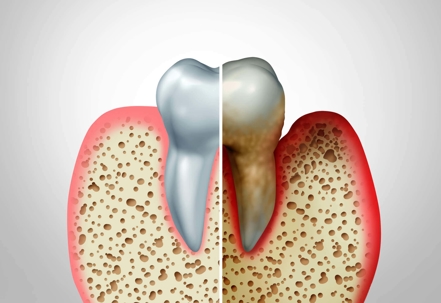Preventing Advanced Periodontal Disease
Periodontal or gum disease (sometimes referred to as gingivitis) is one of the leading causes of tooth loss among U.S. adults. According to the CDC, 47% of adults aged 30 years and older have some form of periodontal disease, which, if left untreated, can slowly destroy the gums and surrounding tissue supporting the teeth.
Preventing periodontal disease is critical to protecting your oral and overall health. Keep reading to learn more about the stages and signs of gum disease, and how our team at ProHEALTH Dental can help protect your teeth.
How Gum Disease Progresses
Also referred to as gum disease, periodontal disease is caused when plaque builds up and turns into tartar, then bacteria begins to grow between your gums and teeth. When bacteria grow, the gums surrounding your tooth become inflamed.
Periodontal disease is progressive and is split into four stages:
Phase One: Gingivitis
In the first and milder phase, gingivitis only affects your gums and is generally indicated by the following:
- Swelling
- Inflammation
- Bleeding when brushing or flossing your teeth
Phase Two: Slight Periodontal Disease
Slight periodontal disease is the second stage of periodontal disease; at this stage, the condition is not reversible but is manageable. At this point, bacteria become more aggressive and the infection spreads to the bone, potentially causing additional bone loss.
Simple oral hygiene can no longer reverse the effects of periodontal disease at this stage. In addition to bleeding or redness of the gums and bad breath, patients may also experience probing depths that are between four and five millimeters.
Dental Probing: Explained
Periodontal probing measures the depths of six areas of each tooth in the potential space between the gum tissue and the tooth. In a healthy mouth, probing depths are between zero and three millimeters.
Phase Three: Moderate Periodontal Disease
At this third stage, the same symptoms as slight periodontal disease occur, however probing depths are greater at six to seven millimeters. This additional space increases the risk of bacteria reaching your bones, and at this point, your bloodstream as well. Your oral health and your overall physical health become even more intertwined, and proper care is essential.
If left untreated, periodontal disease at this stage can progress to:
- Bone and tooth loss
- Gum sensitivity
- Increased bleeding
- Shifting of teeth
Phase Four: Advanced Periodontal Disease
This more destructive phase of periodontal disease can jeopardize your gum health and even your jawbone structure. When the accumulation of bacteria along the base of your gum line occurs, your immune system responds by tackling the build-up, slowly but surely eating away any gum tissue or bone in its pathway.
Risk Factors of Periodontal Disease
This condition can affect your oral health and overall in the long run without proper care; from sensitive and inflamed gums to bone and tooth loss. A person at any age can develop periodontal disease, but there are some ways to know if you’re more prone to experience symptoms according to these factors:
- Systemic diseases (such as chronic kidney disease, rheumatoid arthritis, cognitive impairment, obesity, metabolic syndrome, and cancer.)
- Genetics
- Existing conditions (such as pregnancy and medications such as cancer therapy)
- Lifestyle habits (such as tobacco use and drinking)
Additionally, according to the Centers for Disease Control and Prevention (CDC), periodontal disease is more common in:
- Men than women (56.4% vs 38.4%)
- Those living below the federal poverty level (65.4%)
- Current smokers (64.2%)
Treating Your Gum Disease
From minimally invasive treatments for gingivitis to surgical procedures for more advanced stages of periodontitis, we provide the following services:
- Periodontal maintenance
- Bone grafting
- Gingivectomy
- Guided tissue regeneration
- Gum grafting
- Osseous surgery
- Scaling & root planing
In most cases of early detection of periodontal disease, we can start patients on a maintenance program to get them on the path to a healthier mouth, as well as help you with lifestyle changes to prevent gum disease in the first place.
Achieving Better Oral Health in New York and New Jersey
At ProHEALTH Dental, we aim to break down the historical and outdated separation between dentistry and medicine and unite the two for a more comprehensive approach to providing healthcare services.
By coordinating care with your physician, we aim to address not just your oral health needs, but your overall health and well-being.
Contact us today to schedule an appointment at one of our many convenient offices!

